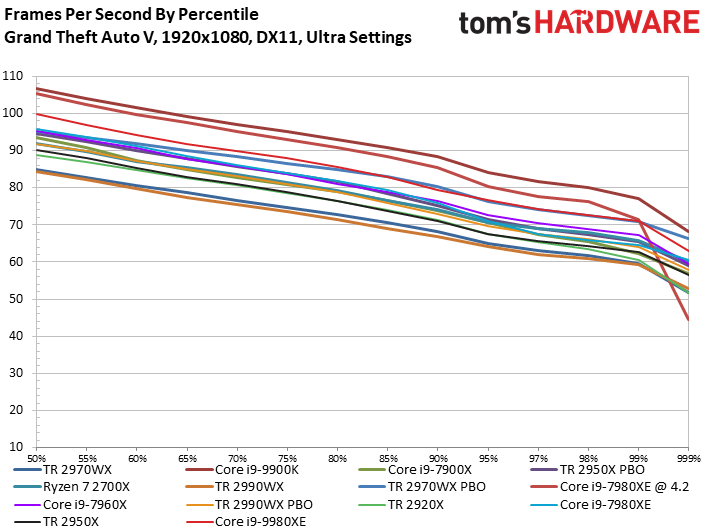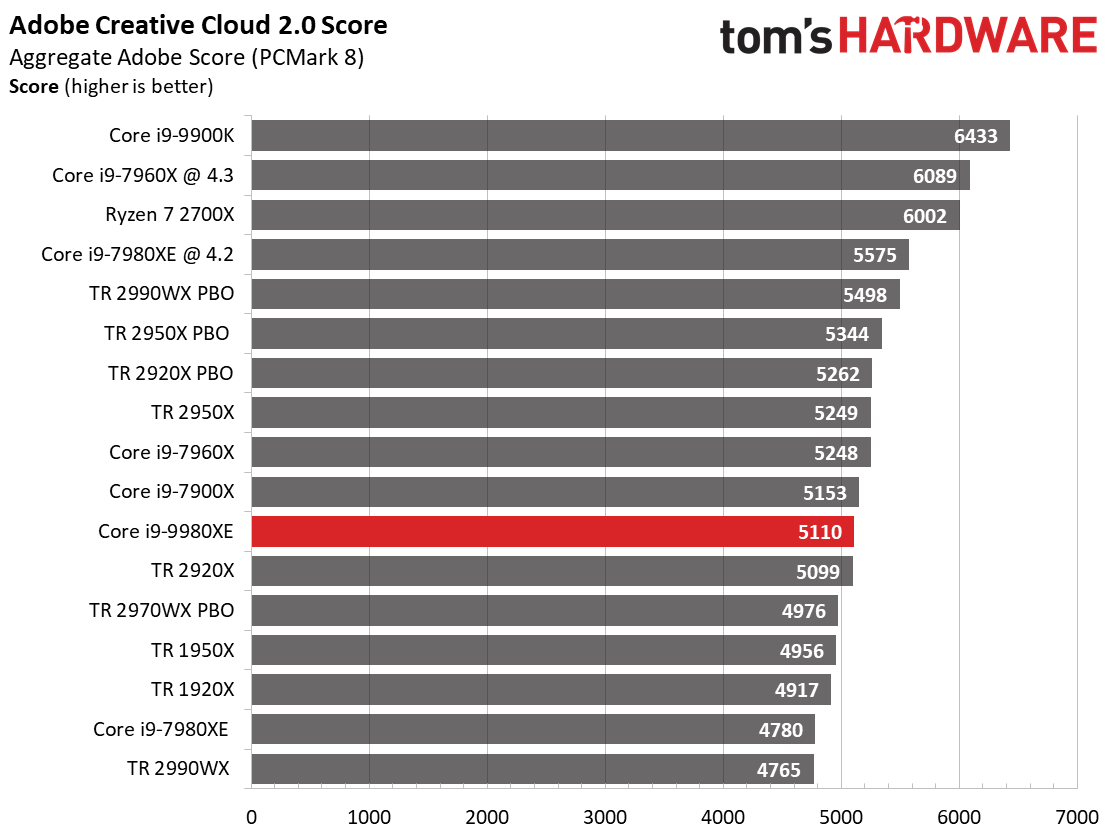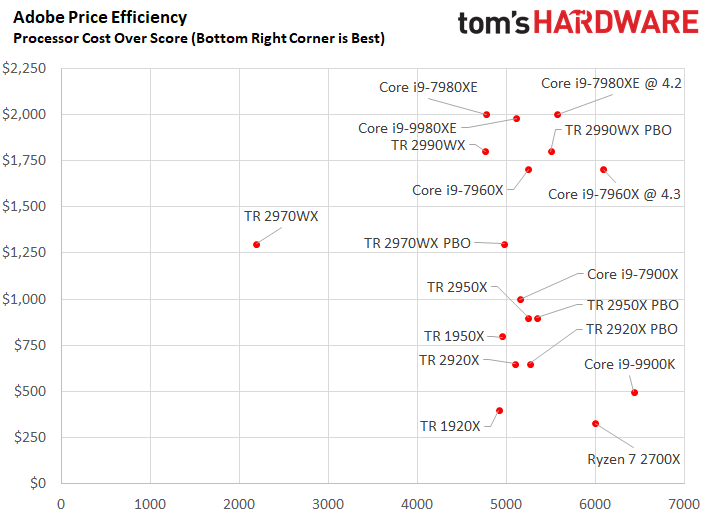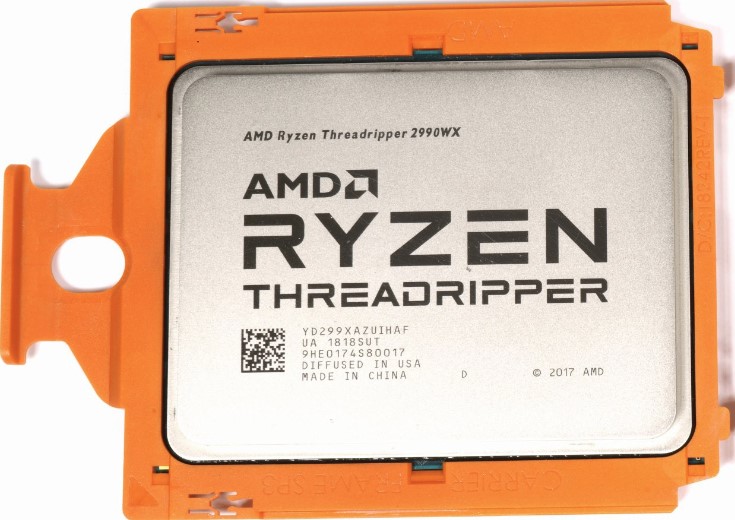AMD Ryzen Threadripper 2990WX vs. Intel Core i9-9980XE: Which High-End Desktop CPU Is Best?
AMD and Intel have both scaled up the core count of their flagship processors recently. AMD shook up the desktop processor market with the launch of its initial Ryzen Threadripper lineup in 2017, forcing Intel to respond. Now we’re into the second post-Threadripper generation and the competition is getting serious, with Intel firing off an 18-core/36-thread Core i9-9980XE to combat AMD's 32-core/64-thread beast, the Ryzen Threadripper 2990WX.
Does Intel’s latest CPU have what it takes to keep AMD’s best off the top of the HEDT (High-End Desktop chip) mountain? Let's explore.
Features
AMD's Threadripper processors excel at heavily multi-threaded workloads thanks to their high core counts. The entry-level Threadripper CPU offers 12 cores and 24 threads for your computing needs, and the top-of-the-line Threadripper 2990WX has three times that many threads to work with.
Due to its unique design, the extra cores on the 2990WX come at the cost of memory throughput and single-threaded performance. As a general rule, CPU clock speeds decrease as core counts grow. As such, the Ryzen Threadripper 2990WX’s base clock is only 3GHz, 500MHz less than then 16-core AMD Ryzen Threadripper 2950X. AMD also limited the maximum boost clock to 4.2GHz on the 2990WX, which is 200MHz slower than the top speed of the 16-core 2950WX.
The Threadripper 2990WX is built in a quad-die layout, which is effectively two dual-die Threadripper 2950X processors in one multi-chip module. Unfortunately, AMD’s Zen+ architecture doesn’t allow all four dies to communicate directly with memory controllers, which limits the performance of the second half of the processor on certain memory-intensive tasks.
AMD’s Threadripper 2990WX lacks memory throughput, but it does support corruption-preventing error-correcting code (ECC) memory, which Intel’s Core i9-9980XE does not support. Intel restricts ECC support to its Xeon-class processor lineup to differentiate its enthusiast-class processors from its enterprise-class offerings. AMD’s processors also natively accept DDR4-2933, whereas Intel’s platform is officially limited to DDR4-2666. Both platforms support quad-channel memory configurations.
Like AMD’s other Zen/Zen+ processors, the Threadripper 2990WX features the company’s Precision Boost Overdrive (PBO) technology, which dynamically adjusts the CPUs parameters to match the current workload and power delivery environment. PBO ensures the CPU always operates at its maximum efficiency and performance output. Think of it as an automated overclocking feature that will extract the most performance possible from the silicon given the capabilities of your motherboard, cooler and power supply.
Get Tom's Hardware's best news and in-depth reviews, straight to your inbox.
| CPU | Intel Core i9-9980XE | Ryzen Threadripper 2990WX |
| Socket | LGA 2066 | TR4 |
| Cores / Threads | 18 / 36 | 32 / 64 |
| TDP | 165W | 250W |
| Base Frequency | 3.0 GHz | 3.0 GHz |
| Max Boost Frequency | 4.4 (Turbo Boost 2.0) / 4.5 GHz (Turbo Boost 3.0) | 4.2 GHz (Precision Boost Overdrive) |
| L3 Cache | 24.75MB | 64MB |
| Integrated Graphics | No | No |
| Graphics Base/Turbo (MHz) | N/A | N/A |
| Memory Support | DDR4-2666 | DDR4-2933 (Varies) |
| Memory Controller | Quad-Channel | Quad-Channel |
| Unlocked Multiplier | Yes | Yes |
| PCIe Lanes | 44 | 64 (Four to the chipset) |
| Architecture | Skylake-X | Zen+ |
Intel’s Core i9-9980XE is built on a refresh of the company’s Skylake-X series. The new processor features 18 physical cores and 36 logical threads, just like the outgoing Core i9-7980XE. But the i9-9980XE features Solder-based Thermal Interface Material (Solder-TIM), which improves heat dissipation. As a result, the new processor features a 3GHz base clock, which is up 400MHz from the Core i9-7980XE.
Intel’s Core i9-9980XE also supports the company’s Turbo Boost 3.0 technology, which increases the clock speed of the CPU when extra performance is warranted. The Core i9-9980XE boosts to different clock speeds depending on the number of cores in use. With 1-2 cores, you can expect 4.5GHz; 3-4 cores can hit 4.2GHz; and with between five and 12 cores active, you should see 4.1GHz. Once you start using more than 13-cores concurrently, the boost clock will dip below 4GHz, and with final two cores active, the CPU will top out at 3.8Ghz.
| Active Cores | 1 -2 | 3 - 4 | 5 - 12 | 13 - 16 | 17 - 18 |
| Core i9-9980XE Turbo Boost | 4.5 | 4.2 | 4.1 | 3.9 | 3.8 |
Winner: AMD. AMD’s Threadripper 2990WX offers almost twice as many cores as Intel’s Core i9-9980XE. It supports ECC memory, and it natively accepts faster memory modules. The 2990WX also boasts 20 more PCIe lanes for bandwidth-intensive components like graphics and NVMe storage, and more than twice as much L3 cache as Intel’s flagship.
Overclocking
If you’re building a workstation-class PC for mission critical tasks, you really shouldn’t be overclocking your processor. However, that won’t stop enthusiasts with deep pockets from buying the highest-end chips, which means there is a subset of customers that will push the limits of even top-of-the-line processors.
If overclocking is what you’re after, Intel’s platform can hit higher maximum clock speeds. AMD presses its silicon near the limits of its capabilities at stock settings, so there often isn't much overclocking headroom. That trend doesn’t change with the high-end Threadripper lineup.
AMD’s Precision Boost Overdrive technology dynamically adjusts the clock rate and CPU voltage to match the given workload. And in our experience, it does a better job at maintaining a good balance of higher single- and multi-core boost frequencies than manually adjusting the motherboard’s parameters in the BIOS.
In most of our test suite, Intel’s i9-9980XE at stock clocks outperforms our overclocked Threadripper 2990WX. But the Core i9-9980XE requires a lot more manual finesse to reach the CPU's highest overclocking potential. You can overclock the Core i9-9980XE, but you'll be tightly restricted by your cooling solution. You'll also need high-end components, like a top-notch power supply, motherboard and cooler, to reach the heights of Core i9-9980XE overclocking.
Winner: Tie If you want to overclock your processor, Intel’s platform will yield higher performance gains than a Threadripper processor, but you'll have to pay dearly for the extra performance. Plan to spend copious amounts of money on premium components to unlock the best the silicon has to offer.
AMD's overclocking headroom isn't nearly as high, but you'll be able to squeeze out gains in several areas without resorting to exotic cooling solutions. Also, don't underestimate the advantages of AMD's PBO, an automated overclocking feature that makes extreme tuning an absolute snap.
Cooling Requirements
Both Intel and AMD enable overclocking on their top-of-the line desktop processors, but keeping these CPUs cool is no easy task–especially once you start cranking up the voltage. Don’t expect an off-the-shelf air cooler to keep the temperatures in line on either chip under heavy workloads if you push the core frequency beyond the stock settings.
Our Intel Core i9-9980XE was stable at 4.4GHz with a Corsair H115i cooler, but the processor was sitting around 95 degrees Celsius after running a benchmark test in Blender. If you’re serious about overclocking one of Intel’s extreme edition processors, plan to build a custom water-cooling loop to expel the heat efficiently.
AMD’s Ryzen Threadripper 2990WX doesn’t produce as much heat as Intel’s flagship processor when overclocked, but you should still spring for a liquid-cooling system to keep the temperatures in check. In our tests, we managed to run the Threadripper 2990WX with an oversized air cooler, and we even enabled AMD Power Boost Overdrive (PBO). But the fan had to spin at full speed to keep up, which made for a noisy computing environment.
We had good results with a Corsair H115i dual-fan closed-loop cooler with AMD's top chip, but we would still recommend a custom loop if you plan to push a Threadripper 2990WX to its limits for extended periods.
Winner: AMD. Intel recommends liquid cooling as a minimum requirement for stock operation of the Core i9-9980XE. Meanwhile, AMD recommends an air cooler for its Threadripper 2990WX. You can get away with an air cooler for the Threadripper 2990WX, but better coolers can extract more performance when overclocking.
Motherboard Options
AMD’s Ryzen Threadripper processors must be paired with an expensive X399-based motherboard with a TR4 CPU socket. Asus, Gigabyte, MSI and ASRock make boards for AMD’s Threadripper lineup, but none of AMD’s partners make a budget option. Expect to pay at least $270 for an X399 motherboard, but some models sell for upwards of $700.
X399 motherboards often come equipped with four 16x/8x PCIe slots with support 4-way SLI and Crossfire setups, high-end audio, Wi-Fi, and network adapters--and you’d be hard pressed to find one without multiple m.2 slots. X399 motherboards are usually well equipped for overclocking with high-quality MOSFETs, VRMs and capacitors and a high level of copper content in the circuitry. In short, Threadripper motherboards are among the best available, but they carry price tags that match their feature sets.
AMD released the X399 chipset alongside the first-generation Ryzen Threadripper processors, and all first-generation motherboards support the second-generation Threadripper processors.
Intel’s Core i9-9980XE also pairs with an existing chipset and fits into an existing socket. Intel reused the X299 chipset for the new i9 chip, which means there are dozens of motherboards on the market that support Intel’s new flagship processor.
Many of the X299 motherboards that you can buy cost as much or more than the average X399 motherboard. However, we’ve seen X299 motherboards sell for under $180 (and one for as low as $99), and there are several options available in the $200 to $250 range, which makes Intel’s motherboards somewhat more accessible than AMD’s.
The higher-priced X299 motherboards offer the same high-end options as AMD’s X399 motherboards, but if you’re not interested in overclocking your CPU to its limits, you don’t need an 8-layer PCB with overweight copper circuitry. And if you don’t like RGB lighting, you can still find X299 motherboards that don’t have on-board blinkers.
Winner: Intel. If you’re in the market for a $1800+ processor, we would not recommend skimping out on a cheap motherboard. However, we must give Intel the advantage here simply for the fact that it gives its customers the option to avoid flashy features that they don’t need. There are also many more choices if you're shopping for an Intel board, as well.
Gaming Performance
We'll be blunt here: If you’re just looking for a gaming CPU, you should probably look elsewhere. These chips are just too expensive to be worthwhile for gamers. Even if you have money to burn, an Intel Core i9-9900K is objectively the better option than either a Core i9-9980XE or a Ryzen Threadripper 2990WX. But if you need one of these CPUs for productivity reasons, it doesn’t hurt to know that when the workday is over, you can enjoy some high-performance gaming.
Both CPUs in this showdown will do just fine for your gaming needs, but Intel’s Core i9-9980XE is unquestionably the stronger contender for gaming workloads. We haven’t even tested the overclocked gaming performance of Intel’s new flagship CPU, and it already enjoys a top-three slot in most of our game benchmarks.
Far Cry 5



Grand Theft Auto V



Middle-earth: Shadow Of War



Hitman



[Note that we didn't re-publish our full gaming test results here. For all our gaming results between the Core i9-9980XE and the Ryzen Threadripper 2990WX, see our review of the Core i9-9980XE.]
AMD’s Ryzen Threadripper 2990WX isn’t as powerful as Intel’s flagship CPU in gaming workloads at sub-4K resolutions, but it’s certainly capable of running games well. The 2990WX performs roughly on par with AMD Ryzen 5 2600X with the frame rate falling within a few FPS for most of our test suite, including Far Cry 5, GTA V, Hitman and Project Cars 2.
Shadow of War leans heavier on GPU horsepower than the processor, so we don't see large deltas between the fastest and slowest CPUs. This is a reminder that many games are limited by a GPU bottleneck.
Keep in mind that once you start raising your gaming resolutions above 1080p resolution, these performance differences tend to shrink as the GPU becomes the bottleneck. When gaming at 4K with the same high-end graphics card, frame rates between the Intel and AMD CPUs here tends to be about the same.
Winner: Intel. The Core i9-9980XE is much stronger than AMD’s Threadripper 2990WX for gaming workloads, but if you buy one of these CPUs just for gaming, you’re missing the point--and wasting your money.
Productivity Performance
A high-core count processor isn’t the most efficient option for most lightly-threaded office productivity tasks, so neither the Ryzen Threadripper 2990WX nor the Intel Core i9-9980XE excel in our office productivity tests.
Intel’s Extreme Edition i9 consistently outpaces AMD’s Threadripper 2990WX in Adobe’s Creative Cloud suite, but lower-cost processors from both companies walk all over these flagship CPUs for these tasks.






Intel’s i9-9980XE also lands in the middle of the pack of our web browsing tests, including Kraken JavaScript Benchmark, WebXPRT and MotionMark 1.0. AMD’s Threadripper 2990WX lands at the bottom of the pack.





The Threadripper 2990WX outperformed the i9-9980XE in our PCMark 10 photo editing test. But in every other test, Intel’s processor took the lead.
Winner: Intel. The Core i9-9980XE is not a good value for productivity workloads, but compared to the Threadripper 2990WX, Intel’s processor is the superior option. That said, if lightweight office work is your primary use for your computer, there are other more-affordable options (from Intel or AMD) that would be a better choice.
Rendering
AMD’s Threadripper 2990WX trails Intel’s Core i9-9980XE in most productivity tasks, but the tables turn when you bring rendering and encoding performance into the mix. The extra cores available with AMD’s Threadripper processor handily outperform Intel’s best processor in heavily multi-threaded workloads.









The Threadripper 2990WX is hands-down the fastest desktop processor that we’ve tested in the POV-RAY raytracing benchmark, with the overclocked Threadripper shaving 12 seconds off the 36-second rendering time that the Core i9-9980XE pulled off.
The Threadripper 2990WX also returned the highest score we’ve ever seen in Cinebench R15 for a desktop processor. With PBO disabled, our 2990WX sample achieved 5175 CB points, which is more then 1,400 points higher than the stock clocked Core i9-9980XE.
Intel’s Core i9-9980XE trampled over AMD’s Ryzen Threadripper 2990WX in single-threaded rendering tasks, but there’s no reason to buy one of these CPUs just for single-threaded applications.
Winner: AMD. AMD’s Threadripper 2990WX excels in applications that can address all the cores and don’t require high single-core performance. And video rendering happens to be one of the best examples of just such a heavily threaded task.
Encoding & Compression
AMD’s platform is far superior for video rendering, but Intel’s platform favors video and audio encoding. If you convert video into different formats with Handbrake, you can save yourself a lot of time with an i9-9980XE compared to a Threadripper 2990WX. Our i9-9980XE sample encoded a 4.19GB MKV file into an MP4 format in 439 seconds, whereas our Threadripper 2990WX required 595 seconds for the same job.







The Intel processor also outperformed our Threadripper while converting a .WAV file to MP3 using LAME, which isn’t surprising because audio encoding is largely a single-threaded operation.
The Threadripper 2990WX also suffers in some workloads, such as multi-core compression, due to memory bandwidth limitations and software/operating systems that aren't designed to accommodate the unique architecture.
Winner: Intel. Intel’s Core i9-9980XE has fewer threads to tackle the big multi-threaded jobs like video rendering and encoding, which cripples its ability to compete with the 2990WX in those types of tasks. But Intel’s superior per-thread performance gives it the edge in tasks that don’t scale well across many computational threads.
Value Proposition
No matter how you slice it, an Intel i9 Extreme Edition or Threadripper WX CPU doesn’t represent a good value for your money if you're running mundane desktop applications. But that’s not what these processors are for. If you’re in the market for a great value on a high-end CPU for common tasks, look for a consumer-level processor, such as a Core i9-9900K or a Ryzen 2700X. If you’re looking for a workhorse CPU that can handle anything your throw at it, expect performance to be prioritized much more more than price.
If we keep the comparison strictly between the Ryzen Threadripper 2990WX and the Core i9-9980XE, the choice is clear. AMD’s processor offers more cores and more threads for heavily multi-threaded applications than Intel’s high-end offering, and it costs less to pick up.










Intel’s processors offer faster single-threaded performance than AMD’s processors. But if you’re only worried about single-thread performance, you probably shouldn’t be shopping for a processor with 18-plus cores.
Winner: AMD. The Threadripper 2990WX’s 32 cores and 64 threads make it an incredible bargain, even with a $1,700+ price tag. AMD’s platform is still a better overall value after factoring the extra cost of an X399 motherboard compared to an Intel X299 board.
Bottom Line
When we started putting this comparison together, we were pretty sure AMD’s Ryzen Threadripper 2990WX would come out on top. After all, we concluded that Intel’s Core i9-9980XE is “too expensive” and “has a hard time scrapping with AMD’s fastest Ryzen Threadripper models.”
But, we’d argue that most people buying a CPU of this caliber probably aren’t doing so primarily for the gaming performance--they certainly shouldn't be. And if office productivity such as word processing, web browsing and mainstream photo editing is your primary goal, there’s no reason to consider a HEDT platform. If you eliminate those two criteria from our comparison, AMD’s Threadripper 2990WX comes out on top as the best high-performance desktop processor.
But if you zoom out and assume that you want the best of everything after paying an astounding premium for this class of hardware, then we come to a dead heat. That leaves you to make the decision based on which of these categories are more important to you in your daily use. Each processor has its benefits, but the Intel processor does offer the best balance of single- and multi-threaded performance, largely because you won't encounter the few worrying performance hiccups born of the Threadripper 2990WX's unique design.
Conversely, if your workloads fit into certain buckets, such as heavily-threaded rendering applications, Threadripper 2990WX delivers a real tangible benefit and you get more cores for less money.
Between these two stupid-expensive chips, it's a tie. But the best overall chip for most HEDT customers is the AMD Ryzen Threadripper 2950X, because it brings you all the goodness of the Threadripper platform for hundreds less than these top-end monster chips. You still get 32 computing threads, plus higher clocks than the 2990WX and fewer memory latency issues due to a lower module / core count. At $899 (and sometimes less if you can find it on sale) the 2950X is an astounding performer and our current favorite HEDT CPU.
| Round | Intel Core i9-9980XE | AMD Ryzen Threadripper 2990WX |
| Features | Row 1 - Cell 1 | ✗ |
| Overclocking | ✗ | ✗ |
| Cooling Requirements | Row 3 - Cell 1 | ✗ |
| Motherboards | ✗ | Row 4 - Cell 2 |
| Gaming Performance | ✗ | Row 5 - Cell 2 |
| Productivity Performance | ✗ | Row 6 - Cell 2 |
| Rendering | Row 7 - Cell 1 | ✗ |
| Encoding & Compression | ✗ | Row 8 - Cell 2 |
| Value | Row 9 - Cell 1 | ✗ |
| Total | 5 | 5 |
MORE: Best CPUs
MORE: Intel & AMD Processor Hierarchy
MORE: All CPUs Content
Kevin Carbotte is a contributing writer for Tom's Hardware who primarily covers VR and AR hardware. He has been writing for us for more than four years.





